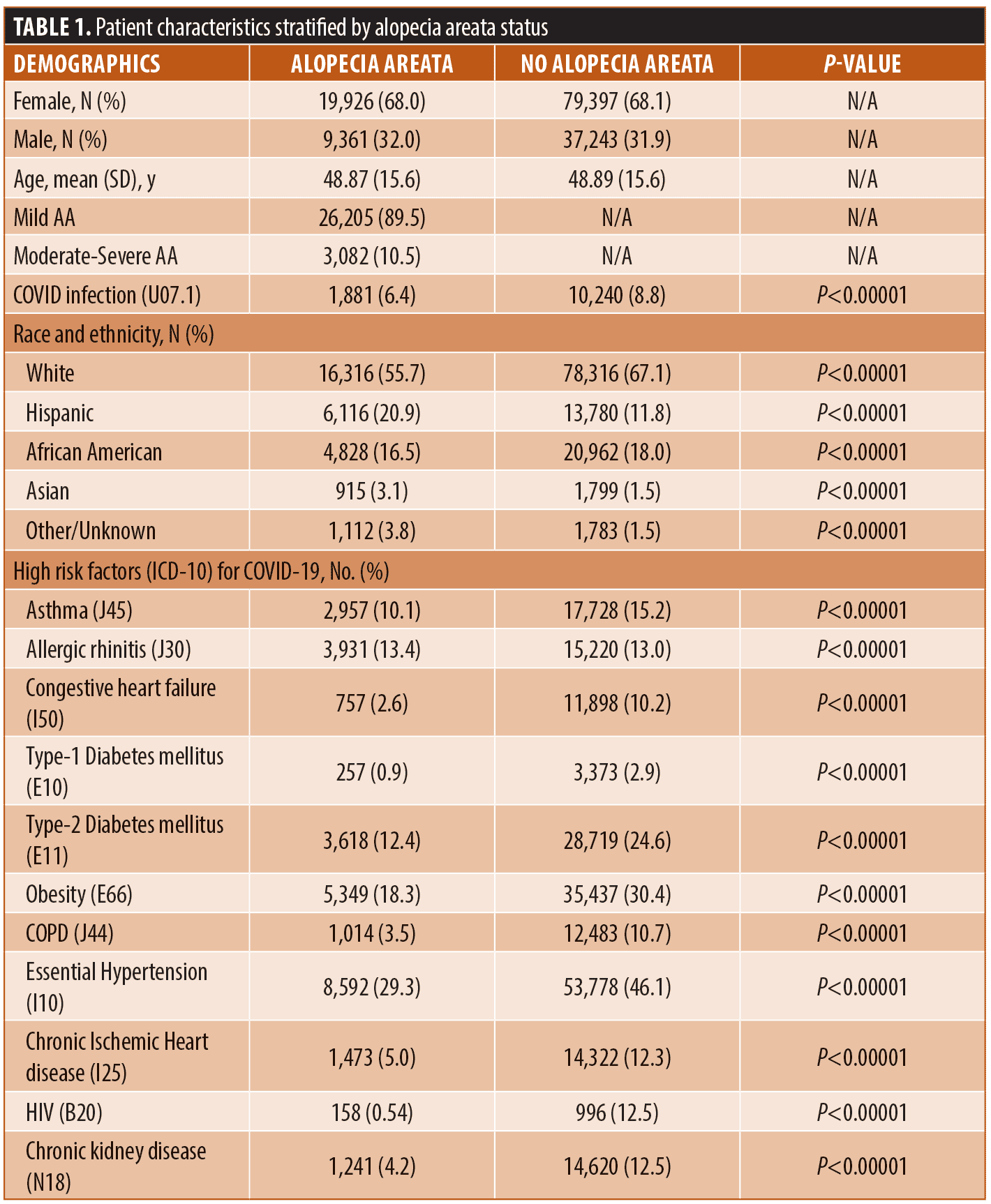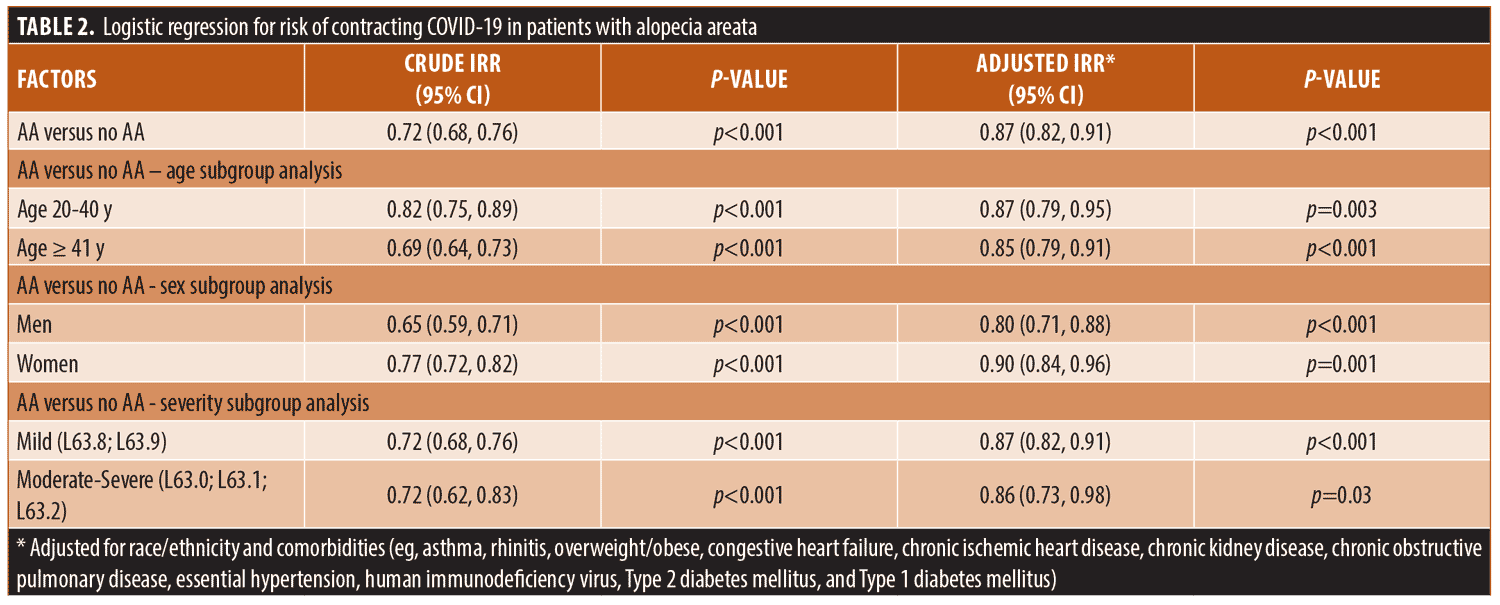 J Clin Aesthet Dermatol. 2022;15(12):19–21.
J Clin Aesthet Dermatol. 2022;15(12):19–21.
by Grace S. Ahn, MD*; Aislyn Oulee, BS*; Shahin Shahsavari, BS; Amylee Martin, MD; and Jashin J. Wu, MD
*Dr. Ahn and Ms. Oulee share co-first authorship of this article. Dr. Ahn is with the Department of Dermatology at the University of California’s San Diego School of Medicine in La Jolla, California. Ms. Oulee and Dr. Martin are with University of California’s Riverside School of Medicine in Riverside, California. Mr. Shahsavari is with the Geisel School of Medicine at Dartmouth College in Hanover, New Hampshire. Dr. Wu is with the Department of Dermatology at the University of Miami’s Miller School of Medicine in Miami, Florida.
FUNDING: No funding was provided for this article.
DISCLOSURES: The authors report no conflicts of interest relevant to the content of this article.
ABSTRACT: Objective. We sought to determine the risk of contracting coronavirus disease (COVID-19) in individuals with alopecia areata (AA) compared to individuals without AA.
Methods. We queried the Symphony Health-derived data from the COVID-19 Research Database, and individuals with a diagnosis of AA from 2019 to 2020 were included in the AA cohort. Subjects with no record of AA diagnosis from 2019 to 2020 were randomly placed in the control group in a 4:1 size ratio compared with the AA group. Laboratory-confirmed cases of COVID-19 between January 1, 2020, and September 1, 2021, were identified.
Results. The AA and non-AA cohorts included 73,784 and 280,991 subjects, respectively. The COVID-19 incidence rate ratio (IRR) for adults with AA was 0.72 (95% CI 0.68, 0.76) compared with adults without AA (p<0.001). Within the AA cohort, moderate-severe AA showed a similar decreased risk in COVID-19 infection compared to mild AA.
Limitations. This study is limited by its retrospective nature and the use of ICD-10 codes for the identification of individuals with AA and COVID-19, which may underestimate the true burden of disease.
Conclusion. Individuals with AA have a slightly decreased risk of contracting COVID-19. Notably, it has been demonstrated that interferon-gamma (IFN- γ) leads to the downregulation of the angiotensin-converting enzyme 2 (ACE2), the SARS-CoV receptor.1 Thus, it is possible that increased levels of IFN- γ seen in individuals with AA confer some protection against this viral infection.
Keywords: Alopecia areata, COVID-19, medical dermatology, epidemiology, infection
Alopecia areata (AA) is an immune-mediated non-scarring hair loss disorder associated with a predominant Th1 cytokine profile.2 Given the immune dysregulation associated with AA, the risk of contracting coronavirus disease (COVID-19) for AA individuals remains a concern for both patients and dermatologists. With the COVID-19 pandemic continuing to pervade the dermatologic community into 2022, it is critical to evaluate potential infection risk and its lethal complications in vulnerable patient populations, such as those with autoinflammatory conditions, to aid clinicians in risk stratification when treating patients infected with AA and COVID-19.
Methods
We queried the Symphony Health-derived data from the COVID-19 Research Database3 and determined the incidence rate ratio (IRR) of contracting COVID-19 in adults with AA compared to adults without AA. Additionally, to account for potential confounders, we performed a secondary analysis in which we adjusted for comorbidities that have been identified as contributing to an increased COVID-19 infection risk in prior studies.
All adults with an AA diagnosis (ICD-10: L63) between 2019 and 2020 were included in the AA cohort. Subjects with no AA diagnostic record were randomly placed 4:1 in the control group compared with the AA group and matched by sex and age. AA cases were subclassified into mild or moderate-severe forms. Mild forms of AA include other alopecia areata (L63.8) and alopecia areata, unspecified (L63.9). Severe forms of AA include alopecia (capitis) totalis (L63.0), alopecia universalis (L63.1), and ophiasis (L63.2). Laboratory-confirmed cases of COVID-19 between January 1, 2020, and September 1, 2021, were identified. Data analyses were performed using R 4.1.
Results
The AA and non-AA cohorts included 29,287 and 116,640 subjects, respectively (Table 1). Logistic regression revealed a crude COVID-19 IRR of 0.72 (95% CI 0.68-0.76) for AA adults compared with adults without AA (Table 2). When adjusting for demographic factors and baseline comorbidities, IRR remained significant but was increased to 0.87 (95% CI 0.82-0.91). Within the AA cohort, moderate-severe AA showed a similar decreased risk (0.86, 95% CI 0.73, 0.98) compared to mild AA (0.87, 95% CI 0.82, 0.91).


Conclusion
In this large population-based study, a diagnosis of AA in adults was associated with a slightly decreased risk of contracting COVID-19. Notably, it has been demonstrated that interferon-gamma (IFN- γ) leads to the downregulation of the angiotensin-converting enzyme 2 (ACE2), the SARS-CoV receptor.1 IFN-γ immunotherapy has proven to be successful in treating a small critically ill immunocompromised COVID-19 cohort.4 Furthermore, it has been previously demonstrated that serum levels of IFN-γ in AA patients are significantly higher than those in controls.5 Thus, it is possible that elevated IFN-γ in AA individuals confer some protection against this viral infection. However, this hypothesis needs to be validated by prospective and experimental studies in animal models of AA.
Individuals without AA had a higher COVID-19 incidence rate, as well as a higher prevalence of comorbidities associated with increased COVID-19 risk. Our results were slightly diminished after controlling for comorbidities, indicating that the increased prevalence of comorbidities in the control group was responsible for some of the difference in risk for COVID-19 infection observed between the two groups. Limited adjustment for potential confounders may have led to residual confounding in the study. Additionally, the relative rarity of AA compared to the relative abundance of COVID-19 may explain the apparent “protective effect” observed in this study. Future studies are needed to elucidate potential mechanisms as well as establish a stronger causal relationship. Our study is limited by its retrospective nature and the use of ICD-10 codes for the identification of individuals with AA and COVID-19, which may underestimate the true burden of disease.
References
- de Lang A, Osterhaus AD, Haagmans BL. Interferon-gamma and interleukin-4 downregulate expression of the SARS coronavirus receptor ACE2 in Vero E6 cells. Virology. Sep 30 2006;353(2):474–481.
- Islam N, Leung PS, Huntley AC, Gershwin ME. The autoimmune basis of alopecia areata: a comprehensive review. Autoimmun Rev. Feb 2015;14(2):81–89.
- COVID-19 Research Database. Accessed September 1, 2021. https://covid19research database.org
- van Laarhoven A, Kurver L, Overheul GJ, et al. Interferon gamma immunotherapy in five critically ill COVID-19 patients with impaired cellular immunity: A case series. Med. 2021;2(10):1163–1170.e2.
- Arca E, Muşabak U, Akar A, et al. Interferon-gamma in alopecia areata. Eur J Dermatol. Jan-Feb 2004;14(1):33–36.

